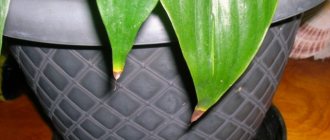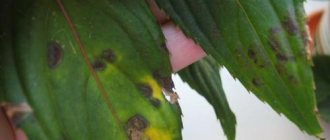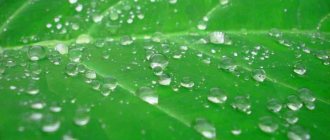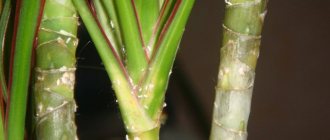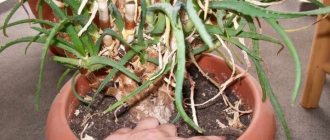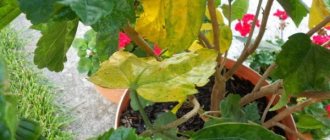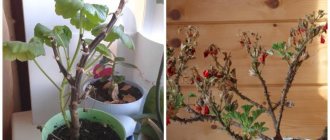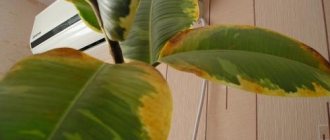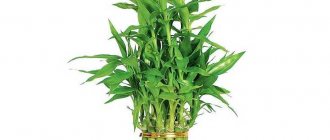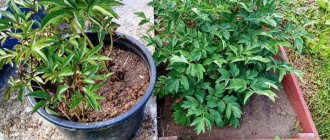Every gardener has encountered the problem of dry leaf tips in indoor plants at least once. It doesn’t matter whether you grow begonias, spathiphyllum, roses or orchids. At the same time, potted flowers do not show other alarming symptoms, continuing to grow and even blooming. Let's try to figure out why the tips of the leaves of indoor plants dry out, whether it is dangerous and how to eliminate the defect.
Most often, yellow, brown and even black dry tips are the result of improper care or a reaction to the activity of pests. The process of natural aging cannot be ruled out. True, the latter can be delayed by creating the most comfortable conditions for the green pet.
Diagnosis is an important stage for prescribing the correct “treatment”
To determine why the leaf tips of spathiphyllum, geranium and other plants turn yellow and dry, diagnose the condition of your green pet. The complexity of the procedure lies in the fact that the search for the cause most often has to be carried out from the opposite direction, i.e. by exclusion method.
- Make sure that the depressed state of the plant is not caused by pests . They like to hide on shoots and on the undersides of leaves, so inspect these places especially carefully. Parasites can also be on the roots. But don't rush to check it out. Perhaps the reason is completely different, and you will only damage the root system in vain.
- Assess the hardness of the water used for irrigation . If you do not settle tap water before watering, plants may suffer from high levels of salts, fluoride, chlorine and other heavy substances that change the characteristics of the soil, making the substrate uncomfortable.
- Compare your fertilization schedule to the recommended fertilization schedule . The reason why the leaves of palm trees, dracaena, ficus, orchids and other crops dry out may be frequent or, conversely, rare feeding.
- Measure air humidity levels . Assess how much air humidity in your apartment is suitable for moisture-loving species.
- Analyze whether the plant is cramped in the pot . One of the alarm bells may be roots emerging from the drainage hole.
- Determine the moisture content of the substrate and the degree to which it dries out between waterings . This can be done either by touch or using indicators that are sold in flower shops.
If you find a deviation from the norm in just one point, the cause of dry ends is usually easy to eliminate. But if, after a preliminary analysis, you see several problems at once, you will have to take comprehensive measures.
What to do if a rose in a pot dries out?
- If a profusely flowering bush, recently brought from a store or received as a gift, suddenly begins to shed its leaves, do not panic, frantically moving it from place to place or increasing watering. In this way, the plant is most likely simply reacting to new conditions. The pot with the newly purchased indoor rose must be placed in a well-lit, warm place that prevents drafts. The best option for its placement is the window sill of a south-eastern or eastern window. After the rose gets used to the new environment, the leaves will stop falling.
- It is much worse if flowers and unopened buds wilt, and the leaves not only fall off, but also turn black. This symptomatology is typical for plants that have been subjected to freezing, fungal infection or attack by insect pests. That is why a pot with a newly purchased rose should not be placed on the same windowsill with other indoor plants. It is better to keep the flower separately for two weeks, carefully monitoring its condition.
- Homemade rose dries in an overly hot room. You can cope with this problem by placing the flower pot in a tray filled with wet expanded clay or moving it away from the central heating radiator, while not forgetting to check the degree of soil moisture in the pot. If it turns out to be insufficient, the flower needs to be watered and then the leaves should be sprayed with a spray bottle.
- Very often, indoor roses dry out due to rotting of the root system, caused either by too frequent watering, which leads to waterlogging of the soil, or by the presence of an overly dense substrate that does not have time to dry out after the next watering. What to do in this case? Having freed the roots from the old soil, the rotten areas (they will be soft, black and transparent) must be removed, and the healthy ones must be washed in a weak solution of potassium permanganate. After this, the root system is kept in a solution of the fungicidal drug “Fitosporin-M” for half an hour. Having taken the bush out of the container with the solution, the roots are dried in air for two hours, and then transplanted into another pot filled with fresh, fertile and loose soil. The transplanted rose is not watered, but only sprayed once a day. Ten days later, the plant is watered with a solution of the same fungicide.
- If the root system of an indoor rose is damaged beyond repair, you can cut several cuttings from the bush and try to use them for further propagation of the plant.
- If the leaves of indoor roses begin to turn yellow, you need to check the soil in the pot: it may be over-moistened. In this case, you should refrain from watering for a while, limiting yourself to spraying the leaves. If there are signs of soil acidification, the rose is replanted using a specialized substrate purchased at a flower shop (it is better to avoid using garden soil). A yellowing rose can be fed with complex fertilizer (Bona Forte and Greenwold produce good results).
- Evidence that the rose is dying as a result of an attack by parasites (thrips, spider mites or aphids) is the appearance of cobwebs, eaten or speckled with dark spots on the leaves, as well as the appearance of insects that are easy to visually observe. You can cope with pests using insecticidal preparations “Aktellik” or “Fitoverm” (several treatments with a seven-day break will be required).
- There is an easy way to rid your indoor rose of spider mites. After thoroughly washing the sponge with a bar of laundry soap, the resulting foam is generously applied to the stems, leaves and soil surface. After half an hour, the foam is carefully washed off with running warm water from the shower head.
- If home roses wither as a result of aphids, you can resort to an infusion prepared from orange peels, poured with boiling water and infused for 48 hours. After spraying the leaves of the affected plants with undiluted infusion, they are covered with cellophane film and left overnight. In the morning the film is removed. New leaves on the bushes appear, as a rule, by the end of the second day. To prevent the appearance of new parasites, the treatment can be repeated.
- Lightening of the leaves of indoor roses can be a consequence of chlorosis. You can cope with the disease by feeding them with mineral fertilizer containing a full range of microelements.
- What to do if an indoor rose has dried out as a result of damage to the root system? You can resort to the help of root formation stimulants, represented by the drugs “Heteroauxin” or “Kornevin”. The roots of the plant, removed from the pot and freed from soil, are placed in a container with a freshly prepared solution for 6-8 hours. After this time, it is transplanted into another pot using a light, fresh substrate.
- If a newly purchased indoor rose sheds its leaves too intensively, you can shorten the branches by 5-6 cm and water it with a solution of a growth stimulator (it is best to take Epin). This manipulation will help the plant cope with stress faster. To prevent the occurrence of chlorosis, after 15-20 days the same plant must be watered with a solution of the drug “Ferovit”. Every 15 days you will need to water it with water acidified with lemon juice (3-4 drops of juice per 100 ml of water).
- If, despite a whole range of measures taken, the leaves continue to wilt, and the green shoots dry out, becoming wrinkled and brown, the soil in the pot can be watered generously. The above-ground part of the bush must be immersed in a basin of cool water and left in it for two hours. You can do it easier by placing a pot with a fading rose in a basin of water. The liquid will seep into the soil through the drainage holes at the bottom of the pot.
Let’s start “treating” indoor flowers: general rules
Regardless of the reason why the leaves of anthurium, Kalanchoe or chlorophytum dry out, any plant could use emergency help, which consists of the following:
- Replacing the surface layer of soil with fresh substrate . This will reduce the risk of soil contamination and eliminate salt deposits from hard water.
- Cleaning the surface of leaves from dust . For plants with delicate leaves, this can be done using a shower. If the leaves are denser and not prone to mechanical damage, use a soft cloth.
You should avoid bathing in the shower if the leaves of plants have edges (such as those of violets).
- Change in air humidity . Spraying, a humidifier, or a regular container of water placed next to the flower will help with this.
If you suspect that the plant has been flooded, do not increase the humidity until the soil dries out.
- Revisiting principles of care . Make sure the plant is getting exactly what it needs from you. Each green pet is individual, and therefore, the care program needs to be selected individually.
How to protect trees from drying out?
The drying out of trees can and should be prevented. To do this you need:
- buy healthy planting material;
- plant seedlings on time, taking into account the climatic features of the area;
- in the fall, bleach tree trunks, including the lower part of the skeletal branches - this will reduce the temperature difference during late winter and early spring changes and protect the trunks from cracking of the bark;
- carry out preventive treatments of the garden against the main range of fungal diseases in a timely manner;
- remove from under plants and destroy diseased foliage (a source of re-infection of trees);
- in spring, summer and autumn, carry out sanitary pruning, removing dried branches, including 4 cm of healthy tissue;
- work in the garden only with disinfected garden tools, especially when moving from plant to plant;
- If necessary, carry out timely watering and soil improvement;
- if there are obvious signs of deficiency of one or another nutrient, apply them by spraying on the leaf;
- If there is a risk of flooding of the area, drain it;
- if necessary, trees can be planted on hills.
Dear readers! The death of any tree in the garden is a disappointment and sadness for the gardener. It’s especially sad when an already fruit-bearing tree dries out. After all, it usually takes several years to wait for the first harvest. We hope that all your trees in the garden will avoid this fate, but if there is the slightest suspicion of possible problems, start dealing with them in time.
Reason #1. Dry air in the apartment
Many representatives of tropical latitudes, for whom warmth and high humidity are the norm, have moved to live in our apartments. But creating such conditions at home can be extremely difficult, especially during the heating season, when the already dry air dries out completely.
Don’t think that you can save the situation by increasing watering. By doing this, you will only achieve rotting of the root system, and therefore, the leaves will receive even less moisture.
The following methods will help increase humidity:
- Spraying . It is advisable to irrigate the leaves with a spray bottle at least 2-3 times a day. Otherwise, this measure will be ineffective.
Spraying is not suitable for plants with blooming flowers (drops falling on the inflorescence can cause it to wilt), as well as for species with pubescent leaves.
- Use of humidifiers indoors . Using a humidifier you can very quickly increase the humidity to the desired level.
- Place the pot on a tray into which wet moss, pebbles or expanded clay are placed in advance . The bottom of the pot should not come into direct contact with the liquid. Moisture from the pan will evaporate, increasing the humidity locally.
- Finding a new place for plants, away from heat sources . If possible, install regulators on the radiators so that the heating intensity can be reduced.
- Temporary transfer to the bathroom or kitchen . In these rooms the air humidity is always higher than in other parts of the house.
Reason #2. Watering indoor plants with hard water
Tap water is usually too hard to water plants with. Moreover, even when settled, green pets do not always like it, because... may contain a lot of salts.
If the reason why the leaves of spathiphyllum, begonia, dracaena, and roses dry along the edges lies in the quality of water, you can suspect the problem by a white coating on the top layer of soil. In this case, you need to proceed as follows.
- Remove plaque (if any) . Try not to damage the root system. Add fresh substrate to the pots.
- Check in the reference book what the plant prefers to “drink” . Perhaps he needs particularly soft or slightly acidified water.
- Avoid watering with running water completely . Be sure to let tap water sit for at least 24 hours (preferably several days). It would be a good idea to strain the liquid before use. If the hardness of even settled water is not suitable for plants, replace it with boiled, melt or rain water.
If the apple tree dries up, how to save it?
- If the reason is the proximity of groundwater , then nothing can be corrected except to maintain the small size of the tree.
- If the reason is soil depletion , then the constant addition of large doses of organic compounds and mineral salts will correct the situation.
- And if soil pests and diseases have settled on the roots, then introducing special poisons into the soil will help. But they must be used with an understanding of the correct dosages and adherence to technology!
- If dryness occurs after a frosty winter , then the dried branches need to be cut out. And spray the crown with a solution with heteroauxin (according to the instructions). This will speed up wound healing and improve the growth of new shoots.
Aphids on an apple tree.
But if young branches begin to dry out at the tips in summer and are heavily covered with aphids , then they must either be removed completely or treated tincture .
Advice! Without accurately identifying the problem, do not use fungicides and insect poisons in vain!
Young apple trees
To prevent a young apple tree from drying out, it is advised to first check its planting site: does it have a negative effect on root growth? Then the young apple tree will need to be transplanted to a new place suitable for its normal further growth.
The presence of parasites on the roots or the presence of fungal infections also provokes drying out, so you must immediately carefully examine the apple tree in order to correctly determine the culprit of the drying. And only then fight this reason.
Dwarf apple tree.
For diseases, and specifically scab, the following remedies are good (for young apple trees):
- Copper sulfate + calcium hydroxide;
- Trifloxystrobin;
- Difenoconazole + ½ flutriafol.
For bark beetles and other corrosive insects, you should use the following medications strictly according to the instructions:
- Aversectin S;
- Pyriproxyfen;
- Malathion.
Reason #3. Violation of the plant watering regime
When asked why the tips of leaves dry out on dracaena, “female happiness,” anthurium, and arrowroot, they usually answer that the plant is overdried. However, not only excessive drought, but also excessive watering can cause this cosmetic problem.
Most indoor plants tolerate temporary “drought” much better than overwatering.
Sometimes it is difficult to understand whether a plant is flooded or too dry. When overmoistened, the leaves lose turgor and look lethargic and lifeless. They seem to be lacking moisture. This is true. The only reason is that the root system is rotten, which means it cannot deliver water to the leaves.
The lower the air temperature in the room, the more dangerous is overwatering.
If you suspect that you have dried out or overwatered the plant, follow our recommendations.
- Check the plant's water needs. Find out whether it needs scanty or abundant watering, and whether it matters if the soil clod dries out between waterings. Also check which method of watering the flower prefers - standard or in a tray.
- Analyze the quality of drainage and drain holes . Overmoistening, which results in rotting and deterioration of the air permeability of the soil, can be caused by a hole in the pot that is too small or a lack of drainage. If so, repot the plant. If there are no problems with drainage, let the earthen ball dry out almost completely, and only then water the plant.
- During drought, water more often and more abundantly . But do not let the liquid stagnate in the pan. Carry out the next watering after at least a few inches of the top layer of soil have dried out - for moisture-loving crops and after the middle layer of soil has partially dried out - for succulents and other low-drinking species.
- Consider buying a pot with self-watering . This invention will save you from the hassle of individually selecting the frequency of watering for each plant.
- Buy a soil moisture meter . Use the device every time before watering to understand how much water the plant needs.
You can water a flower regularly, but it will still suffer from thirst if the amount of water remains insufficient. The surface of the soil may remain wet, but the liquid will not reach the roots. It is not difficult to make sure that moisture reaches the roots. Just pour water until it starts to seep into the pan.
Causes and treatment of yellowing leaves
Drooping, limp leaves and an unhealthy appearance of the plant are not so often combined with yellowing, but diagnosing the cause of the depressed state of the plant is much easier than in the case of blanching, the obvious symptoms of which usually appear at serious stages of damage. In all cases where the yellowing of leaves was preceded by their blanching, it is necessary to combat the problems of blanching. But if wilting is accompanied only by yellowing, then we are talking about several other problems - excess rather than lack of fertilizers, insufficient watering and diseases.
| Signs of a problem | Cause of withering |
| Withered leaves gradually turn yellow at the tips, the process spreads further, in a neglected state the tips of the leaves turn brown and dry out, and the plant stops growing and stops flowering | Poor watering, frequent drought |
| Before turning yellow, the leaves not only wither and lose turgor, but also curl | Aphid damage |
| On limp leaves, yellowing gradually spreads, starting from the tips, followed by wet spots on the greens and stems, indicating a problem | Damage to wet bacterial rot |
| The foliage gradually turns more and more yellow, and tiny black dots appear on the underside, somewhat reminiscent of mold. | Dry rot damage |
| In a lethargic-looking plant, the stem and underside of the leaves turn yellow, especially in the area adjacent to the root collar; in a neglected state, the root collar turns black | Fusarium infection |
| Yellowing and limp appearance are characteristic mainly of the lower leaves. Flowering is gradually disrupted - the color changes, the flower stalks are shortened | Excess potassium |
| In a wilted plant, the oldest leaves turn yellow and there are signs of premature or accelerated aging | Excess phosphorus |
If the yellowing of a flaccid plant is caused by insufficient watering , then the problem is solved by correcting watering and dividing the usual procedures into frequent but light ones. Typically, water for irrigation is added a couple of times at intervals of several hours or the earthen ball is saturated by immersion in water, subsequently maintaining the humidity level that is suitable for a given plant.
Infection of plants by aphids always manifests itself not only in visible traces of insects, but also in a depressed state and difficult recovery. You need to fight this stubborn pest with diligence: even if you managed to cope with the problem, extra preventive treatment will not hurt. After all, even one female insect is enough for it all to start again. To combat aphids, you can use showering and washing, smoking, biological agents (decoctions and infusions of dandelion, potato and tomato tops, pyrethrum and chamomile, nettle, wormwood, yarrow, tobacco) or insecticides - from simple laundry and potassium soap to selinon, detoil , karbofos and modern drugs.
Wet bacterial rot is most often associated with the purchase of plants from unverified sellers, private gardeners and flower growers who use contaminated soil. You can combat the problem by treating with copper-containing preparations (copper-soap mixture, Bordeaux mixture, copper oxychloride) or chemicals such as nitrafen, oxychome, phthalan and iron sulfate. But if you ignore the yellowing and lethargy, you most likely will not be able to cope with the disease.
combat dry rot immediately with the use of insecticides and biological preparations. Both the above-ground parts of plants and the soil need to be treated. You can use infusions of marigolds, mullein or wood ash, horsetail decoction, Bordeaux mixture and any systemic broad-spectrum fungicides.
Fusarium with biological agents (infusions and decoctions of horsetail, mullein, ash, marigolds) and various fungicides (from copper oxychloride, Bordeaux mixture, iron sulfate and phthalan to systemic drugs). This is a very dangerous disease, delay in treatment of which can cause the death of the plant.
An excess of any fertilizer can be dealt with only by stopping fertilizing, adjusting the composition of the fertilizer and changing the substrate if its reaction and composition are not suitable for the plant.
Wilting houseplant. © plantz
Reason #4. Plant oppression by pests
If pests are noticed on the leaves or stems, this may be the main cause of the yellowed tips. The parasites drink the cell sap, thereby infecting the leaf. In this case, treatment measures must be taken as quickly as possible, because The problem may not be limited to dry ends alone. In addition, the plant can infect its healthy neighbors.
In addition to parasites such as aphids, scale insects, and spider mites, gardeners should also be wary of fungal diseases. They destroy leaf after leaf until the plant is completely destroyed. The fungus can often be recognized by the brown spots that accompany wilting and drying of the leaves.
Complex therapy includes the following stages:
- isolation of the diseased plant from other crops;
- washing the leaves with soapy water;
- increased air humidity;
- application of insecticides;
- disinfection of pots before replanting.
Since the diseased plant may have come into contact with other crops, strengthen safety measures for other indoor flowers.
The best protection against pests is prevention of their occurrence. Therefore, always treat the pots before planting, use only packaged soil or calcine garden soil. And never place recently purchased flowers next to the permanent inhabitants of your home flower garden. Isolate “new arrivals” for at least a month to ensure they are healthy.
The apple tree is drying out because the roots have been eaten by the larvae of the May beetle (chafer).
This happens with young apple trees, up to 5 years old - these insects do not harm old ones. Larvae can be found by digging up the soil under trees.
Symptoms of the problem
It’s not just individual branches of a tree that dry out—it dries up as a whole.
What to do?
As practice shows, insecticides do not help against beetles - the drugs kill only those pests that are located shallowly. But they are capable of penetrating to a depth of 1 m and no poison can reach them there.
You can get rid of cockchafer larvae using ammonia: 50 g (pharmacy bottle) per bucket of water. The consumption rate is a bucket per tree. Pests cannot stand this smell, but the tree has only one benefit from ammonia - it is a wonderful nitrogen supplement. This procedure is carried out in mid-May.
Reason #5. The pot is too small for the flower
Brown leaf tips may appear if the plant is planted in a pot that is too tight. By the time the roots have taken over the entire space of the flowerpot, the soil will have already been depleted, which means that the flower will be sorely lacking in nutrition. Finding out if this is what caused the problem is easy. If roots are already visible from the drainage hole, then an emergency transplant is required.
What is the threat?
There are many reasons for the wilting of spathiphyllum, but most of them are easily removable. It is important to detect the disease as early as possible . In advanced cases, when the roots rot, most often the plant cannot be saved. The leaves gradually dry out and fall off, and the roots die off (read more about why spathiphyllum can die and how to save the plant here).
Reason #6. Lack of light or direct sunlight
Incorrect placement can also cause leaf tips to turn black. Moreover, both too bright light (direct sunlight) and lack of lighting lead to a similar result.
When trying to understand why the leaves of flowers dry out, it doesn’t hurt to analyze whether direct sunlight burns the plant. This provokes the appearance of not only brown tips, but also entire spots. This phenomenon occurs especially often after spraying on a sunny day.
Yellowing due to lack of light looks different. It manifests itself as an uneven loss of color and may be accompanied by the dropping of leaves (hibiscus behaves this way most often).
- Find out which window (north, east, southwest, etc.) the flower prefers to grow on, and try to find a suitable place for it.
- If it is not possible to place the pot on a bright window, get an additional lamp. This can be a special phytolamp or a regular fluorescent one.
- If the leaf tips are turning yellow on only one side of the flower, try rotating the pot from time to time to ensure all shoots receive enough light.
- Protect the plant from bright sunlight using blinds or regular cardboard (its size should correspond to the height of the flower), which should be placed between the window and the flower pot during the daytime.
Leaf tips dry out due to pests
When attacked by pests, plant leaves not only lose moisture and shape, they do not become limp, but immediately turn yellow and fall off. Most often, home flowers are attacked by sucking pests, that is, those that deprive them of juice. The most common pests are:
- Aphid. The size of the insect does not exceed 3 mm in length. Aphids are very difficult to get rid of. Firstly, the insect attacks the plant in huge numbers, and secondly, it has a strong immunity to many known drugs. A flower affected by aphids quickly loses its natural green color, becomes deformed and dies.
- Shield. The size of the insect ranges from 3 to 7 mm. The body of the pest is covered with a protective shell, which is why the insect got its name. At first glance, the scale insects on the flower resemble small brown growths. But if the plant slows down in growth, the leaves begin to deform and change color, brown spots appear on the buds and stems, this is a sign of a scale insect attack.
Thrips on the leaves of home flowers
- Mealybug. Outwardly, it is very similar to the scale insect, only its color is milky white. The mealybug secretes a cotton-like mucus that closes the pores of the leaves and prevents sap flow inside the plant. The pest multiplies not only on the surface of the indoor flower, but also in its root system. Often affects anthurium and spaciphyllium.
- Thrips. Insects grow in the internal tissues of the plant. They are capable of destroying an adult flower in 20-25 days. Females most often attack plants with large, long leaves, for example, dracaena, palm, some varieties of ficus, etc.
- Spider mite. The very first sign of the appearance of this pest is a thin web entangling the leaves and stems. Having hit one plant, it jumps to the one next to it. It develops very well at relatively low air humidity and high temperatures.
Pests can be controlled using different methods. In the early stages, you can get rid of insects mechanically, removing them from the plant manually. For preventive purposes, biological methods are used, which include treating flowers with soap solutions or tinctures based on natural ingredients.
Important! Chemicals are used when neither the first nor the second method helped.
Reason #7. Drafts in the apartment
The plant can grow quietly in a cool room. But it will react very poorly to sudden temperature changes caused by cold air masses. Drafts are detrimental to almost all indoor flowers. As a result, slightly yellowish spots appear on the leaves, which fade until they become translucent.
The source of drafts and cold air currents can be not only an open window, but also a running air conditioner or fan. Place the pot where the influence of cold air is minimal, and the flowers will again thank you with lush and juicy greenery.
Lack of moisture
Bare tops and dry branches in the crown of a plum tree may be a sign of lack of moisture. Moreover, a tree can experience water deficiency not only during growth, but also during dormancy. Gardens planted on loose soils that are unable to retain water suffer from a lack of moisture even in winter, and if there is a snowless, frosty winter with multiple transitions through 0, the problem is even worse.
To prevent the trees from drying out and save the future harvest, plums planted on sandy or peat lands are thoroughly watered before the onset of cold weather and then the soil is mulched.
Reason #8. Incorrect feeding scheme for indoor flowers
Excessive care for houseplants often causes yellowing of the tips. This is especially true for those gardeners who like to apply fertilizers, guided by the principle “the more, the better.” As with watering with hard water, a white coating may form on the surface of the substrate, which needs to be removed. Be sure to stop feeding.
Yellow tips can also signal that you have not fed the plant for a long time or have not taken care of its balanced diet. The lack of elements manifests itself in different ways.
- Potassium deficiency : the tips and edges of the leaves turn yellow, but the veins do not change color.
- Nitrogen deficiency : tips and veins turn yellow. The leaves become smaller and gradually lose their color saturation (even turning white).
- Calcium deficiency : leaf tips turn brown, leaves become deformed and curled. The defect occurs in soils that are too acidic or too alkaline.
- Zinc deficiency : Leaves look like they are sunburnt. They lose color. The veins protrude.
- Iron deficiency : leaves turn yellow and become smaller. The veins retain their green color, but become more convex.
If only the tips of indoor plants dry out, and the leaf blade itself remains healthy, this rarely leads to serious problems. Although, of course, all this spoils the appearance of the flower and the mood of its owner. If it's just a matter of dry air, perhaps everything will go away after the end of the heating season. But if the reason is more serious, then you cannot turn a blind eye to the flower’s disease, so as not to aggravate the situation.
Causes of drying out
Any plant demonstrates health by its appearance. If it is exposed to any discomfort, or is not satisfied with the conditions of detention, then the first pathological changes will appear on the leaves. To fix the problem, you should find out the main reason why the tips of the leaves of flowers dry out.
Problems may include:
- The indoor air is too dry. Most often, it is the lack of moisture that causes the leaf plate to dry out. This process starts from the ends.
- Watering ornamental plants with low-quality water. This problem comes down to watering flowers with unsettled or hard water.
- The soil in the pot is very waterlogged.
- Fertilizers used for feeding are not used correctly. Moreover, the reason why the tips of the leaves of a houseplant dry out can be either a lack of fertilizer or an excess of it.
- Sunburn. In this case, the edges of the leaves begin to deform and turn brown. However, if the sun's ray hits the middle of the leaf, a brown spot appears in this area.
- The room temperature is too high.
- The root system has grown excessively, the result of which is that the free space in the pot will be filled with roots. In this case, the nutrition of the flower is disrupted.
- Development of diseases.
- Parasites have appeared in a flower pot.
